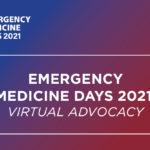Winter 2021: Pediatric Committee
The COVID-19 pandemic has affected the population in all aspects of life, including healthcare utilization. Despite the morbidity associated with the ongoing pandemic, many reports have described a reduction in emergency department (ED) utilization. This reduction is perhaps most notable in the pediatric population.
Anecdotally, multiple physicians and medical directors in Florida have reported declines in pediatric patient visits to EDs. The decline appears to be true for general EDs and pediatric EDs, with some pediatric EDs experiencing decreases in patient volume greater than 50% compared to the same period last year. This trend was particularly notable early in the pandemic, following the statewide stay-at-home order and during the mid and late summer, when the number of COVID-19 cases increased dramatically. As 2020 cames to a close, many EDs were still experiencing significantly reduced pediatric volumes in comparison to previous years.
The decline in pediatric visits is not unique to Florida and has been documented in several studies. A single center study from Cincinnati, OH comparing pediatric ED visits from March 16-April 30, 2020 to the same period in 2018-2019 found a significant reduction in daily volume.[1] At a large tertiary children’s hospital, Chaiyachati et al. identified a significant decrease in the mean number of daily visits in 2020 compared to 2017-2019, as well as an increased proportion of high acuity patients (ESI 1, 2, 3). Though common chief complaints were similar to previous years, a significant increase in trauma was identified.[2]
International studies also document similar declines. A large Canadian study evaluating ED visits for children 0-16 years of age in 18 hospitals, including a tertiary care children’s hospital, found an overall decline of 66.7% in visits during the peak of the COVID-19 pandemic relative to the same time period in 2019. The decline was most notable in general EDs (70%), but it was also significant at the children’s hospital (57%). The proportion of admissions during the study period increased, though the total number of admissions relative to the previous year decreased.[3] In Germany, a single center study evaluating pediatric emergency healthcare utilization during March and April 2020 noted a 63.8% decline in visits compared to the same period in 2019. Similar to the Canadian study, the proportion of admissions increased in the German study,[4] but all studies noted declines during peak pandemic times and in association with local public health measures to mitigate spread of COVID-19.
Why have pediatric emergency visits declined so significantly? The answer is likely multifactorial. Physical distancing, school closures and other measures aimed at reducing the spread of COVID-19 may have reduced the spread of other communicable illnesses. Parent/caretaker reluctance to visit EDs for lower acuity conditions may have also contributed. Finally, healthcare utilization may have shifted to alternative resources, particularly for lower acuity concerns, such as telemedicine.
Considering the ongoing decrease in pediatric visits to EDs, how can pediatric ED resources be efficiently utilized during the COVID-19 pandemic? Fraymovich et al. addressed that question recently in “A Blueprint for Pediatric Emergency Resource Reallocation During the COVID-19 Pandemic” (Pediatric Emergency Care).[5]Some of their findings and recommendations, in brief, consisted of:
1. Physical space: Reallocate a portion of the pediatric ED’s physical space for adult patient use. The remaining pediatric ED area can be reconfigured for pediatric patients while maintaining a designated area for pediatric resuscitations and an infant/newborn warmer.
2. Clinical services: Increase the maximum age of patients seen in the pediatric ED and by PEM providers (keep directing adult patients that are intoxicated, incarcerated, critically ill, or in respiratory failure to the adult ED). Additionally, pediatric admissions can be transferred to a local children’s hospital to preserve inpatient beds.
3. Staff reallocation: Decrease physician provider staffing to meet the projected need, and reassign pediatric ED nurses to other parts of the ED to meet demand.
The COVID-19 pandemic is far from over. EDs, staff and practitioners have demonstrated tremendous resilience and innovation in response to the pandemic. Despite declines in pediatric patient visits, pediatric ED resources are still a vital resource. Reimagining and reconfiguring pediatric ED resources may help with the COVID-19 impact on adult patients. ■
References
- Even L, Lipshaw MJ, Wilson PM, Dean P, Kerrey BT, Vukovic AA. Pediatric emergency department volumes and throughput during the COVID-19 pandemic. Am J Emerg Med. 2020 Sep 28:S0735-6757(20)30870-6. doi: 10.1016/j.ajem.2020.09.074. Epub ahead of print. PMID: 33010994.
- Chaiyachati BH, Agawu A, Zorc JJ, Balamuth F. Trends in Pediatric Emergency Department Utilization after Institution of Coronavirus Disease-19 Mandatory Social Distancing. J Pediatr. 2020 Jul 20; 226:274–277.e1. doi: 10.1016/j.jpeds.2020.07.048. Epub ahead of print. PMID: 32702427; PMCID: PMC7370904.
- Goldman RD, Grafstein E, Barclay N, Irvine MA, Portales-Casamar E. Paediatric patients seen in 18 emergency departments during the COVID-19 pandemic. Emerg Med J. 2020 Dec; 37(12):773-777. doi: 10.1136/emermed-2020-210273. Epub 2020 Oct 29. PMID: 33127743; PMCID: PMC7604790.
- Dopfer C, Wetzke M, Zychlinsky Scharff A, Mueller F, Dressler F, Baumann U, Sasse M, Hansen G, Jablonka A, Happle C. COVID-19 related reduction in pediatric emergency healthcare utilization – a concerning trend. BMC Pediatr. 2020 Sep 7; 20(1):427. doi: 10.1186/s12887-020-02303-6. PMID: 32894080; PMCID: PMC7475725.
- Fraymovich S, Levine DA, Platt SL. A Blueprint for Pediatric Emergency Resource Reallocation During the COVID-19 Pandemic: An NYC Hospital Experience. Pediatr Emerg Care. 2020 Sep; 36(9):452-454. doi: 10.1097/PEC.0000000000002203. PMID: 32732779; PMCID: PMC7386675.
This article is part of the following sections:
Samantha manages fcep.org and publishes all content. Some articles may not be written by her. If you have questions about authorship or find an error, please email her directly.







